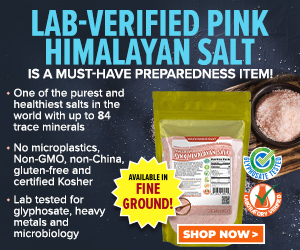
Eat Natto and Care for Your Cardiovascular System Naturally
Friday, February 20, 2009 by: Barbara L. Minton
Tags: natto, health news, Natural News
- Newly released JFK files reveal Pentagon's role in creating Lyme disease and covid in the same lab
- Oncologist warns of ‘terrifyingly aggressive’ cancers in children, linked to immune suppression from COVID vaccines
- Trump administration CUTS FUNDING to Gavi, the Vaccine Alliance - a major blow to the Bill Gates-backed entity
- Health Ranger Report: Ashton Forbes discusses TELEPORTATION ORBS and their role in MH370 disappearance
- Musk targets “strangely wealthy” lawmakers in DOGE probe, names Pelosi, McConnell, Schumer
- NIH study, buried for decades, reveals that Flu Shots INCREASE elderly deaths, not prevent them
- EPA banned chemical linked to cancer, Parkinson's and fatal heart defects in babies - now industry is lobbying to get it reinstated
- Millionaire fitness coach charged in Tesla vandalism incident as anti-Musk attacks escalate
- Woman contracts WORLD'S DEADLIEST VIRUS after unknowingly being given the WRONG VACCINE
- At least 75 percent of Americans are unknowingly MEDICATED FOR STUPIDITY by fluoridated water – Utah now banning it
- “Ethically sourced” human “bodyoids” could usher in a new era of medical exploitation, raising disturbing ethical questions
- COVID-19 scandal linked to CANCER SURGE: Billionaire researcher sounds alarm
- Civil war is here – Multiple events, from conservatives being “swatted,” to attacks against Telsa owners, happening across America as Dem politicians are telling supporters to ‘fight in the streets”
- U.K. unveils controversial pandemic preparedness tool: A double-edged sword?
- Tackling the rubber waste crisis: Groundbreaking study reveals eco-friendly method to recycle tires
- DARPA: The shadowy innovator behind the world’s most advanced military technologies
- NYT admits U.S. ran Ukraine war operations-Russia's victory exposes obsolete NATO tactics, says Mike Adams
- Homesteading Boom: How families are escaping cities to grow their own food
- Newly released JFK files reveal Pentagon's role in creating Lyme disease and covid in the same lab
- Analysis: The coming economic collapse, a mass uprising and Trump's three secret weapons to halt the growing revolt
- Trump's greatest betrayal so far: Accelerating Middle East wars, silencing dissent, and serving Zionist masters
- CDC finally halts $11 billion COVID funding scam as health officials admit the ‘pandemic’ was a fraud
- The hidden dangers in your kitchen: How cooking methods impact diabetes, cancer and aging
- Kiss Your Genetic Privacy Good-Bye! 23andMe Gets Green Light to Sell Your Intimate Genetic Details to Anyone They Want
- DEADLY DECEPTION: How COVID vaccines increased mortality rates and why authorities hid the truth
- Dr. Suzanne Humphries makes bombshell appearance on Joe Rogan podcast, exposing vaccine industry deception back to POLIOMYELITIS
- Trump nominates VACCINE ZEALOT Susan Monarez to lead the CDC, sidelining RFK Jr.'s reform efforts
- Here are TEN all-natural ways to protect your garden without using harmful chemicals
- Woman contracts WORLD'S DEADLIEST VIRUS after unknowingly being given the WRONG VACCINE
- Senate Democrats deny censorship industrial complex existed, defend government's role in silencing dissent
- Black cumin seed oil emerges as a powerful ally against breast cancer and chronic inflammation
- Sugar-free deception: Artificial sweeteners hijack hunger signals, fuel obesity epidemic, study warns
- “Independent” anti-Russia outlet MEDUZA faces COLLAPSE as US funding dries up
- The Health Ranger releases “Vaccine Zombie” song and music video, using AI-animated zombies for the music video
- Discovery of vast underground city beneath Giza pyramids challenges human history
- Key nodes of Federal Government censorship
- Newly released JFK files reveal Pentagon's role in creating Lyme disease and covid in the same lab
- California's social media censorship law struck down: A victory for free speech or a threat to online safety?
- EPA advisor admits the agency is funneling billions to climate groups ahead of Trump’s return to White House
- The Health Ranger releases “Vaccine Zombie” song and music video, using AI-animated zombies for the music video
- Dr. Mike Yeadon releases 15-minute testimony - WATCH - about genocidal intent of COVID “vaccines”
- Florida takes a stand: DeSantis proposes permanent ban on mRNA vaccine mandates
- “Why we influenced the 2020 elections”: Facebook files reveal the coordinated effort to bury the Hunter Biden laptop story
- Mike Adams releases country western hit single: Goin’ Back in Time is Comin’ Home
- The pandemic as a tool for INDOCTRINATION: Understanding “The Indoctrinated Brain” by Dr. Michael Nehls
- Unpacking the Lies That We’ve Been Fed – new song and music video released by Mike Adams, the Health Ranger
- Mike Adams releases music poetry sensation: A Child of God
- House Intelligence Committee calls for the ARREST and PROSECUTION of Dr. Anthony Fauci
- Rep. Nancy Mace introduces bill to ban biological males from female facilities on federal property
- Michigan sheriff announces criminal investigation into 2020 election crimes, Dominion Voting Systems
- Peter Rost exposes Big Pharma corruption in his book “The Whistleblower: Confessions of a Healthcare Hitman”
- Migrants are taking advantage of recent hurricanes to scam residents and loot their homes
- Sugarcane extract superior to cholesterol-lowering drugs?
- Survival 101: Effective EMF blocking techniques
- Red Cross issues warning to stop blood plasma donations from vaccinated people
- Scientists confirm: GENIUS brain function can be spontaneously unleashed in humans without any apparent cause
- EPA advisor admits the agency is funneling billions to climate groups ahead of Trump’s return to White House
- HYSSOP: What research reveals about the health benefits of this ancient holy herb
- Two containers with completed ballots fall out of truck in Florida
- Fully vaccinated about to see “tsunami” of illness and death, warns virologist
- Global leaders unite to clamp down on “misinformation” with UN-backed Cascais Declaration
- BREAKING: 2025 NDAA authorizes mandatory military draft of WOMEN across America… as Pentagon pursues global NUCLEAR war with both Russia and China at the same time
- Michael Yon warns of a ZIONIST TAKEOVER in Trump’s second administration
- BOMBSHELL: DNA testing kits are a SCAM to develop ethnic-specific bioweapons
- Ozempic and Wegovy weight loss drugs are injectable LIZARD VENOM PEPTIDES that may unleash a devastating wave of organ failure… side effects align with symptoms of SNAKE BITES
- Israeli soldiers accused of even more torture and abuse in the West Bank
- These 13 countries just signed an agreement to engineer a global FAMINE by destroying food supply
- NASA admits that climate change occurs because of changes in Earth’s solar orbit, and NOT because of SUVs and fossil fuels
- RFK Jr. clears key hurdle: Sen. Susan Collins backs controversial HHS nominee, signaling a new era for health policy
- Sermon 30: How Jesus reveals Caesar’s FAKE CURRENCY and FALSE AUTHORITY
- Coriander seeds: Ancient medicine backed by modern science
- Arizona officials claim Maricopa County needs 10-13 days to tabulate results of the election
Natto offers powerful protection against blood clotting and stroke
According to Japanese folklore, natto was introduced to Japan by a Samurai warrior. The ancient Samurai ate natto on a daily basis and even fed it to their horses to increase their speed and strength. In 1980, a researcher at the University of Chicago discovered nattokinase, the enzyme in natto that provides fibrinolytic activity. Nattokinase is a proteolytic enzyme that breaks up blood clots before they have a chance to become dangerous, and promotes heart and vascular health. Its action reduces thrombosis that can lead to heart attacks, pulmonary embolisms, and stroke.
Natto is a daily breakfast for many Japanese
Natto was originally made by placing soybeans in a rice straw pouch that naturally contained the fermenting bacillus. Now natto is made from steamed soybeans fermented by a culture of bacillus subtilis natto. Being fermented for 24 hours, the soybeans develop a brown color, a sticky gooeyness, and a distinctly fermented aroma that resembles cheeses such as blue cheese or roquefort. After smelling natto, people tasting it for the first time are surprised by its nutty, savory flavor.
A popular breakfast in Japan is created by:
1.Placing natto in a small bowl
2.Stirring it
3.Adding real fermented soy sauce (not sold at traditional grocery stores), and stirring again
4.Adding chopped green onion and karashi mustard if desired
5.Placing the mixture on streamed rice and eating
Other ingredients can be added if desired, such as broth, grated daikon, or okra. In some parts of Japan, natto is dusted with sugar. Natto is also used as part of other foods, such as sushi, toast, salad, or noodles. Natto can be added to miso soup to make a nutritional powerhouse. There is also a dried from of natto without the gooeyness that is eaten as a nutritious snack. Some producers make a low or no odor natto. About 236,000 tons of natto are consumed in Japan every year.
Natto is mass produced and sold at markets in small containers or paper wrappings that contain between two and four individual servings along with some condiments. Sometimes it is sold frozen. When the individual container is opened, the natto is ready to be stirred, mixed as desired, and eaten. Ready to eat natto provides a quick and highly nutritious breakfast or lunch.
Natto is loaded with nutrition
Natto contains a full spectrum of amino acids and is an excellent complete vegetarian protein. Natto is a good source for lecithin, which prevents arteriosclerosis, improves memory retention, and increases concentration ability. It has saponin, which is said to suppress carcinogens, relieve constipation, and slow the aging process. It contains high levels of Vitamin K, involved in the formation of calcium binding groups of proteins assisting the formation of bone, and preventing osteoporosis. Vitamin K2 is found in fermented food products such as cheese and miso. Natto has large amounts of K2, approximately 870 micrograms per 100 grams. In addition, natto is an excellent source of selenium.
Natto contains high amounts of the newly discovered Vitamin PQQ, a critical nutrient for skin health. Mice deprived of PQQ showed poor overall development and low integrity skin. PQQ is essential to the mammalian diet, meaning it can only be obtained from food sources.
Polyamines are potent anti-inflammatory agents that also have an immune system normalizing effect. Natto has a higher content of polyamines than any other food.
Chemicals alleged to prevent cancer are contained in natto, although their effects are controversial. These act as phytoestrogens in women and men, locking into estrogen receptors and displacing the estrogen produced by the body. The most well known of these are genistein and daidzein.
Natto has been shown to have a cholesterol lowering effect in studies. It has an antibiotic effect and was used as medicine against dysentery during World War II.
Natto encourages weight loss by its high nutritional density and low calories. There are approximately 90 calories and 8 grams of protein in a serving.
Nattokinase promotes cardiovascular health without side-effects
As the benefits of the nattokinase enzyme found in natto become apparent, people find they have an alternative to toxic drugs for maintaining cardiovascular health. Nattokinase complements the body's natural clotting and fibrinolytic processes and keeps circulation flowing smoothly. It helps raise body energy levels by delivering oxygen rich blood to organs and tissues.
The ability of nattokinase to increase circulation helps prevent cancer, since cancer can only thrive in cells where oxygen levels are reduced. Healthy circulation means more nutrients from food and supplements are carried throughout the body and made available for use. This helps joints stay cleaner and free of pain. It also promotes a high level of oxygen to the brain for quickened mental processing.
The body naturally produces its own fibrinolytic enzyme, called plasmin. Production of plasmin decreases during the aging process. This is one reason why the risk for cardiovascular disease and stroke increases so much as people get older. Eating natto providing the nattokinase enzyme is the natural way to continue fibrinolytic action in the body. For anyone not wanting to eat natto, Nattokinase is available as an individual supplement, and also as part of several proteolytic enzyme combination supplements.
Natto found to reduce amyloids that lead to Alzheimer's disease and reduce hypertension
This is a period of renewed interest in enzyme activity in the body and respect for the importance of enzymes in all bodily processes. New research into the roles of enzymes in achieving and maintaining good health regularly highlights their critical nature. Two new studies on nattokinase have extended the knowledge base to include insight into their function in the brain and in blood pressure regulation.
A newly released study published in the January edition of Journal of Agriculture Food and Chemistry noted that more than 20 unrelated proteins can form amyloid fibrils related to various diseases, such as Alzheimer's, and systematic amyloidosis, excessive deposition of amyloids in the tissues of the body. Enhancing amyloid clearance is one of the targets of therapy for amyloid-related diseases. Researchers studied the amyloid-degrading ability of nattokinase, and found it capable of amyloid hydrolysis, the dissociation of amyloids in water.
Natto found to reduce hypertension
The April, 2008 issue of Hypertension Research reports a study examining the effects of nattokinase supplement on blood pressure in subjects with pre-hypertension or stage one hypertension. In their randomized, double-blind, controlled trial, 86 participants ranging from 20 to 80 years of age received nattokinase or a placebo capsule for an eight week period. Compared with the control group, the net changes in systolic blood pressure and diastolic blood pressure were -5.55 mmHg and -2.84 mmHg respectively, after the eight week intervention. A proteinase released by the kidney that normally acts to raise blood pressure by activating angiotensin was also reduced.
How to make natto
To create your own soybeans fermented with the natto baccilus, start with:
Small soybeans, sometimes sold as natto soybeans
Natto bacillus starter (available online or in health food stores)
Procedure:
1.Wash the soybeans and soak them in water for 12 to 20 hours. Soybeans will swell.
2.Steam the soybeans for 6 hours or use a pressure cooker.
3.Mix the beans with the starter bacterium bacillus subtilis natto. Take care to keep ingredients away from impurities and other bacteria.
4.Allow the mixture to ferment for 24 hours at a temperature of about 105 degrees.
5.Refrigerate the mixture for one week to allow for the breakdown of the soy protein into easily digested amino acids. This process creates the stringy, gooey sauce of the natto.
For more information:
Hsu RL, Lee KT, Wang JH, Lee LY, Chen RP, "Amyloid-degrading ability of nattokinase from Bacillus subtilis natto", Journal of Agriculare Food and Chemistry, January, 2009.
Kim, JY, Gum SN, Paik JK, Lim HH, Kim KC, "Effects of nattokinase on blood pressure: a randomized, controlled trial", Hypertension Research
You Tube How to Eat Natto.
Natto: The Newest Soy, Nutrition Science News, NewHope.com.
Nurses Thoughts: Health Benefits of Natto, www.nursesthoughts.com.
Natto, Wikipedia.
About the author
Barbara is a school psychologist, a published author in the area of personal finance, a breast cancer survivor using "alternative" treatments, a born existentialist, and a student of nature and all things natural.Natto at FETCH.news
Get independent news alerts on natural cures, food lab tests, cannabis medicine, science, robotics, drones, privacy and more.
Take Action: Support Natural News by linking to this article from your website
Permalink to this article:
Embed article link: (copy HTML code below):
Reprinting this article:
Non-commercial use OK, cite NaturalNews.com with clickable link.
Follow Natural News on Facebook, Twitter, Google Plus, and Pinterest
Science News & Studies
Medicine News and Information
Food News & Studies
Health News & Studies
Herbs News & Information
Pollution News & Studies
Cancer News & Studies
Climate News & Studies
Survival News & Information
Gear News & Information
News covering technology, stocks, hackers, and more



"Big Tech and mainstream media are constantly trying to silence the independent voices that dare to bring you the truth about toxic food ingredients, dangerous medications and the failed, fraudulent science of the profit-driven medical establishment.
Email is one of the best ways to make sure you stay informed, without the censorship of the tech giants (Google, Apple, Facebook, Twitter, YouTube, etc.). Stay informed and you'll even likely learn information that may help save your own life."
–The Health Ranger, Mike Adams












































